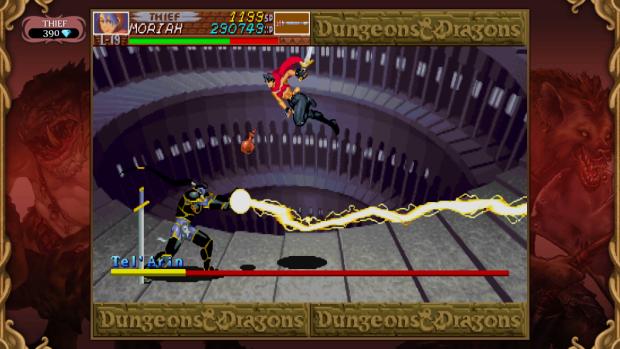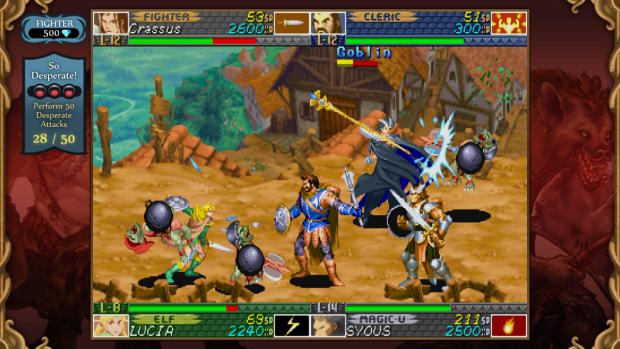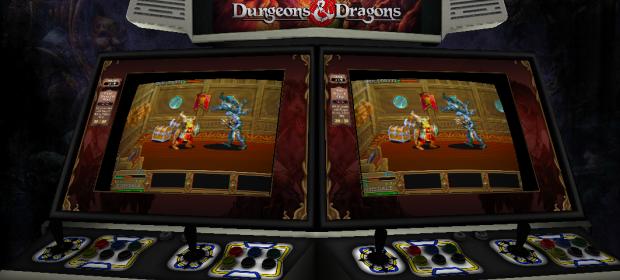If you walked into an amusement arcade in the 1990s, there would have been a strong possibility you would have encountered a Capcom side-scroller. As well as their titanic Street Fighter franchise that changed the coin-op landscape forever, the wily folk over at Capsule recognised the supreme cash-guzzling potential in walking from left to right while beating the crap out of everyone. Final Fight laid down the marker in 1991, and was followed by a succession of increasingly more sophisticated attempts at the genre, taking on board licenses, SFII-style moves and more powerful variations of the CPS hardware.
Chronicles of Mystara documents two of Capcom’s most elegant, fondly remembered titles: 1993’s CPS-1 Dungeons & Dragons: Tower of Doom and its CPS-2 sequel Shadow Over Mystara from 1996. Blending the patented scrolling hack-and-slashery with role-playing elements and the crucial inclusion of the Dungeons & Dragons license, the duo were brilliant arcade games that used Gygax and Arneson’s source material in a way that was respectful enough to appeal to fans of the tabletop game, and kicked enough ass to tempt arcade-goers to part with their cash.
Apart from a scaled-down Japan-only Sega Saturn port, the games have never been released on home consoles. Iron Galaxy have once again stepped up to the plate and delivered their trademark brand of classy, old-school HD reverence. Sometimes, returning to retro arcade games can be a harsh lesson to the modern gamer, as a childhood fave comes off as a dated and repetitive mess, treated particularly unkindly by the passage of time. Not so with these bad boys. If anything, what you notice most prevalently is how influential they have been on games that have followed.

Tower of Doom is the best place to start once you’ve had a browse of the splendid menu screens and decided whether to play with or without filters, scan-lines, or the curious over-the-shoulder arcade cab view that Iron Galaxy are so fond of. The presentation is superb, as you would expect.
You make your choice from four staple D+D classes – fighter, cleric, elf and dwarf – and embark on a quest to take down the evil Arch-Lich, Deimos. Along the way you encounter a wonderful bestiary of foes that will be instantly recognisable to fans of the OG board games. Before you know it you are tangling with Owlbears, setting a regenerative Troll on fire to finish him off, and facing up to a creepy, multi-eyed Beholder. What set the game apart from its contemporaries is the use of magic and items. In past Capcom games you would pick up cursory items to gain points, or food items to replenish your vitality. Here, there are a plethora of coins, gems, armour upgrades, projectiles and spells to find.
Each character is also completely unique and has different abilities, strengths and weaknesses. Playing as the Fighter, you can expect a better range of attacks and a selection of daggers, hammers and other projectile weapons. The Dwarf will not sustain damage from enemy projectiles that fly over his head, and can string together extremely quick combo attacks. The Cleric wields tomes and spells that can attack as well as heal, but he can also inflict blunt trauma with his non-bladed weaponry. Rounding things out is the speedy Elf, who has a bunch of missile attacks, can pick open locked treasure chests and is adept at identifying booby traps. Gauntlet and even Golden Axe had done this kind of multi-character thing before, yet the amount of depth Capcom introduced was staggering for an arcade game of the time. There are also lots of nice nods to the tabletop game – witness the Cleric unleashing the Turn Undead spell, or the names of familiar settings from well-known D+D campaigns.

Tower of Doom plays extremely well today, especially in four player, with the branching levels and hidden Easter Egg-y treasures still proving to be a delight. Just as it was eclipsed three years after its original release, ToD gets a sound kicking on this double pack from the incredible Shadow Over Mystara sequel. The 1996 title was Capcom’s penultimate side-scroller, followed only by the brilliant comic book and b-movie influenced Battle Circuit. It was released at a time when the gaming landscape was changing dramatically, and would see Capcom shift their attentions towards the likes of Resident Evil. Adding two new character classes, the Thief and the Magic User, Mystara also introduced a load of ace new moves that could be pulled off using button and joystick combinations, allowed two different human players to select the same class of character, and used the clout of the CPS-2 hardware to make the sprite-based 2D visuals look utterly stunning.
Even now, this is a seriously nice-looking game, with huge, bold characters and some superbly designed enemies. Capcom even paid attention to one of the weaknesses from its predecessor – the fact that you pick up items using the attack button, leaving you open to damage in an item-strewn situation, is rectified by allowing you to slide along the floor, picking up items as you do so. It is still very much risk/reward, but seems much fairer. The branching levels are even more prevalent here, as are the little secrets and nuances that whisk the player away from the amusement arcade and into the realms of something far more sophisticated. There are eight different slots that can be used to house upgrades in your armour or special items, a more in-depth trading system available at the between-level shops, and a staggering amount of endings depending on how you perform.

Iron Galaxy have helped make two highly enjoyable arcade titles of yesteryear even more fun by adding their usual challenges and achievements. There are tasks for you to perform, such as collecting coins, opening a specific number of treasure chests, or killing a set amount of foes. In return you level up your profile and can also unlock some tasty extras like examples of the beautiful concept art. The fusion of the manga-influenced Capcom art-style and the arcane world of Dungeons & Dragons certainly makes this a worthwhile pursuit. You can also unlock fun “House Rules” which allow you to employ what are tantamount to cheat codes to help your passage through the broken Lands of Glantri. Multiplayer is implemented in excellent fashion – allowing you to play online with three others, even in a drop-in/drop-out basis, or providing the old-school thrill of enjoying a four-player game locally, just as you would have done back in the day.
VERDICT: Once again, Iron Galaxy deliver the goods. Can these guys do no wrong when given a Capcom-related task to undertake? With production values that shame many a retro remake, this package showcases two of Capcom’s finest scrolling fighters, that once added a welcome RPG feel and proved that there was much more to the genre than button bashing and multiple continues.

VERY GOOD. An 8/10 is only awarded to a game we consider truly worthy of your hard-earned cash. This game is only held back by a smattering of minor or middling issues and comes highly recommended.





